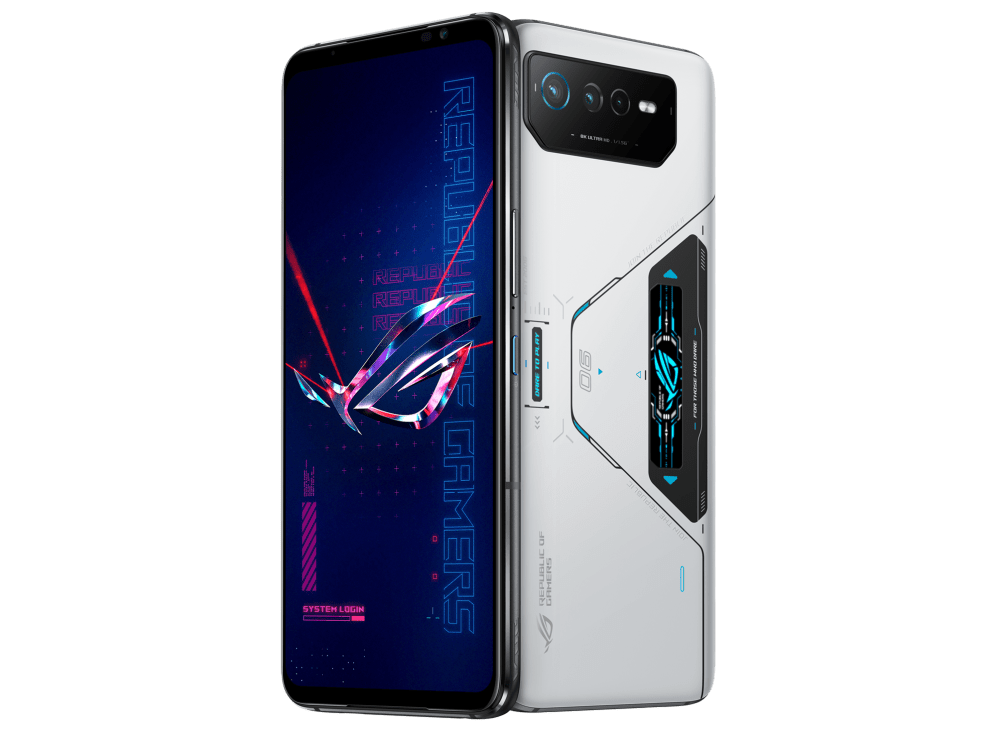
Due to the difficulty most people will have in actually obtaining a handset from the series, the Asus ROG range of smartphones is not very well known. You might need to import one if there are no “regular” stores nearby where you can buy one. However, previous smartphones in this line, such as the ROG Phone 5, typically go all-out on specifications, and the Asus ROG Phone 6 Pro does that as well. It boasts two USB-C connectors, the Snapdragon 8 Plus Gen 1, dual front-firing speakers, and even a headphone jack.
The nice thing about gaming phones is that everything that works well for gaming will work well for everything else as well. Consider this: a fantastic display is wonderful to use even when you’re not gaming. speakers for video games? good for music listening as well. The camera is the sole component of the phone that is unimportant for gaming, hence it is underpowered in comparison to the other components. However, this year isn’t really all that horrible either.
The Asus ROG Phone 6 Pro is unquestionably worthwhile considering if what you’re looking for is a super-powerful phone with great specifications and you don’t mind the camera not being the finest of the best. It’s expensive, but it also has the craziest specifications of any phone I’ve used recently. It truly offers everything.
Asus ROG Phone 6 Pro: Specifications
| Build | Corning Gorilla Glass VictusIPX4 water resistance |
| Dimensions & Weight | 173 x 77 x 10.3mm239g |
| Display | 6.78-inch FHD+ AMOLED2448 x 1080p resolution (395PPI)165Hz refresh rate720Hz touch sampling rate5-800nits brightness @APL100 + HBM1200nits peak brightness @APL1111.23% DCI-P3 coverage150.89% sRGB coverage1,000,000: 1 contrast ratio Pixelworks i6 processor |
| SoC | Qualcomm Snapdragon 8 Plus Gen 1Adreno 730 GPU |
| RAM & Storage | Up to 18GB LPDDR5 RAMUp to 512GB UFS 3.1 storage |
| Battery & Charging | 6,000mAh65W wired fast charging support |
| Security | In-display fingerprint sensor |
| Rear Camera(s) | Primary: 50MP IMX766Ultra-wide: 13MPMacro: 2MP |
| Front Camera(s) | 12MP IMX663 |
| Port(s) | Dual USB 3.1 Gen 2 Type-C3.5mm headphone jack |
| Audio | 5-magnet 12×16 Super Linear Speakers2x Cirrus Logic CS35L45 with 15V boost Tri-microphone array |
| Connectivity | 5G4G LTEWi-Fi 6EBluetooth 5.2LDAC, aptX, aptX HD, aptX adaptive, AACNFC |
| Software | ROG UI & Zen UI based on Android 122 OS upgrades and 2 years of security updates |
| Accessories/other features | Aero case Hypercharge power adapter ROG Vision color PMOLED display |
Asus ROG Phone 6 Pro: Design
With an inflated package and an augmented reality unpacking, the ROG Phone experience starts with the unboxing itself. Check out our dedicated article on the Asus ROG Phone 6 Pro unpacking to learn more about what’s included.
The Asus ROG Phone 6 Pro’s biggest feature is that it isn’t a gaming phone with a distinctly gaming design. I’ve seen worse, and I appreciate that Asus isn’t scared to try new things. On the power button and the SIM tray, Asus added some accenting. Where the ultrasonic Air Triggers are located on the aluminum frame, there is also ROG branding. Although the back of the device has a lot of writing, the camera module and lighted “dare to play” emblem are attractive.

Of course, one of the most distinctive features of this phone’s design is the display on the back. There are several pre-made animations that may be enabled in various settings, as well as a variety of animations that you can add yourself. I enjoy seeing that on phones because it’s enjoyable. Perhaps it’s not your cup of tea, but you can disable it or use it as a notification ticker if you like.
However, the Asus ROG Phone 6 Pro does something unique with its display: there is neither a notch nor a punch-hole. This contributes to the screen’s size in part because it is completely free of obstructions because to the front-facing camera’s placement above the screen. But you also receive more than that. Speaking of throwbacks, you get two front-facing speakers with identical sound quality on either end, as well as a notification LED. The most you can do is disable it for each individual programmed, which is inconvenient, but it’s amazing that it’s even there.
The Asus ROG Phone 6 Pro’s display is superb, with a 165Hz AMOLED panel that can provide up to 1200 nits of brightness. The lower resolution display was chosen in order to push performance because 1440p requires a lot of graphic processing power to render. Every little bit of overhead saved is important, especially when attempting to achieve higher frame rates like 165 FPS. It’s not an LTPO display, despite the fact that you can lower the refresh rate to as low as 60Hz (which also unlocks a DC Dimming option).
The Asus ROG Phone 6 Pro, however, has an even higher touch sampling rate, which is 720Hz, comfortably surpassing many of the competition. According to Asus, the Asus ROG Phone 6 Pro has a touch latency of 23ms and scans for input every 1.4ms as a result of the higher touch sampling rate. While it can read input every 1.4 MS, there is a discrepancy because it still needs to analyze that input.
But in addition to being quick, the display also supports HDR10+ and is driven by a Pixelworks i6 processor. Tone mapping in HDR and refresh rate calibration may both be done using the Pixelworks i6 processor. Although Asus hasn’t specified how AI is employed in this instance, it essentially offers a way to apply AI to improve the screen quality. There are movements for turning off the screen so you can still draw letters on it to initiate actions.
On the left side of the phone, there is a second USB-C connector that is superior to the bottom-firing one. It is where some accessories (like the Aero Active cooler) are plugged in and it allows HDMI output. The regular USB-C port, which is located next to a 3.5mm headphone jack, is located at the bottom of the device.
The Asus ROG Phone 6 Pro also includes “Air Triggers,” which is a neat trick. They are ultrasonic zones on the phone’s side that can be used to detect different types of inputs and can be used to map touch inputs into actions in games. They offer a squeezing motion that you may use regularly and are also usable across the system. I have it set up so that Google Assistant gets called when I squeeze the phone in my hand. You have the option to enable a long squeeze, a short sweep, or a long press gesture when you long-press both triggers.
In games, Asus’ Air Triggers can detect the following:
- Tap
- Dual partition buttons (tap each side of the button)
- Swipe across
- Slide across (slower)
- Tap and swipe
- Tap and slide
Finally, the haptics of the Asus ROG Phone 6 Pro feels excellent in the hand. Typing is a great experience, and you won’t miss phone calls or notifications when the phone is in your pocket if you’re relying on vibration. Asus did a great job here, as they’re punchy without feeling over the top, and they avoid feeling “mushy” as some other phones may feel.
Asus ROG Phone 6 Pro: Performance
One word best describes the purpose of the Asus ROG Phone 6 Pro: gaming. Almost every aspect of this phone was planned with attention for how it would impact the gaming experience, and performance is crucial for gaming. This phone features 18GB of LPDDR5 RAM, the fastest UFS 3.1 storage (and a lot of it), and the Qualcomm Snapdragon 8 Plus Gen 1 CPU, which is the most potent. On paper, this is the quickest Android smartphone, and it actually matches that performance.
With a Cortex-X2 prime core clocked at 3.2GHz, three Cortex A710 performance cores clocked at 2.8GHz, and four Cortex A510 efficiency cores clocked at 2.0GHz, the Snapdragon 8 Plus Gen 1 has an enhanced Qualcomm Kyro CPU. The improved CPU, according to Qualcomm, is 30% more power-efficient and 10% faster than the one on the Snapdragon 8 Gen 1 chip. In testing the Snapdragon 8 Plus Gen 1 reference device, we discovered comparable results that Asus

The ROG Phone 6 Pro is as quick as you may anticipate.
The speed of this phone is exactly what you would expect it to be, and although we’ll talk more about it in the battery section, the efficiency is also satisfactory. This is the fastest phone I’ve ever used, and it’s quite powerful. I’ve been playing a lot of Ratchet & Clank and The Simpsons: Hit & Run, but pretty much every game you can imagine will run without a hitch. Both games allow me to keep a steady 60 frames per second, yet emulation is among the most taxing tasks any smartphone can undertake. The phone with the Kunai Gamepad and the Aero Active was with me on a recent flight from Dublin to Berlin.


